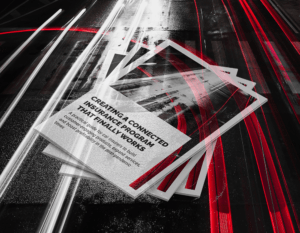
Creating a Connected Insurance Program That Finally Works
A practical guide for car insurers to build customer-engaging products, expand services, and boost profitability in the post-pandemic times.
… Read More
As worldwide data is growing exponentially, car insurance companies are tapping into IoT-based technologies to gain an edge. By leveraging data, they may unlock significant benefits, from improving the cost/claim ratio to providing distinctive and personalized services. What do they need to embrace the evolving trend of connected insurance? We explain.
Connected insurance (or IoT insurance) uses the data from connected devices, such as telematics equipment installed in the vehicle or trip recorder mobile apps, to determine risks more precisely. This data is further aggregated and analyzed to offer accurate insights into each person’s driving behavior, enable more accurate customer segmentation, and develop innovative insurance products, such as usage-based rewards programs.
Because of the tremendous potential of telematics in reducing costs, the insurance market has lately emerged as one of the fastest-growing sectors in the global IoT area. It is expected to reach nearly $403 billion within the next five years, rising at a stunning CAGR of 54% over the forecast period.
These results indicate that connected insurance is gaining momentum, and several factors contribute to that trend. One of them is the continuous advancement in telematics, which no longer relies on basic static data generated by external devices. Instead, it factors in dozens of complex vehicle systems and contextual parameters to paint a complete picture of the driver’s behavior in particular circumstances, all this directly coming from the vehicle’s embedded IoT.
Another enabler contributing to the increasing interest in IoT car insurance is the rising adoption of predictive analytics. This technology has permeated the mainstream in recent years. It is pulling on increasingly more complex machine learning and AI processes and algorithms to produce insights insurers can act on. In addition, the growth of 5G and enhancements of other connectivity protocols have further lifted the potential for connected technologies.
Finally, somewhat unexpectedly, insurance data analytics owes the accelerated development to the pandemic. On the one hand, digital transformation in business has picked up speed amid lockdowns and social distancing measures, which opened a new chapter for innovation. As companies went online, the use and popularity of digital insurance channels surpassed that of direct broker services, which have usually been limiting the deployment of telematics-based insurance. On the other, many industries increased their investment in insurance when faced with unprecedented times. Individual consumers, too, became much more open to new insurance offerings leveraging disruptive technologies, and specifically IoT-based insurance.
IoT can drive fundamental change in the car insurance industry, bringing insurers closer to customers on an individual level and empowering better decision-making through insights. In particular, the following key opportunities are arising for car insurance providers from the use of advanced car telematics:
The growing usage of IoT opens a new opportunity for insurance providers to innovate their offerings and reduce the premium and risk-related costs. Creating accurate risk profiles based on driver behavior, usage of driver assistance systems and the context of driving, is a gateway to competitive products that delight customers and compel them to stay.
For example, insurers can use actionable, telematics-based insights from analytics to provide individual driver discounts matching their profile or build a unique rewards program. In addition, by enabling smart pricing, data-based solutions further help insurers maximize profit margins and design profitable pricing strategies that unlock bigger sales. Telematics also opens the door for usage-based, or pay-as-you-drive insurance, where the cost of insurance changes dynamically depending on the usage, vehicle, and driving behavior.
Lowering claims payment is essential for high underwriting income. Unfortunately, a quick look at research data confirms that rising claims frequencies and persisting severity increases continue to eat into insurers’ profits. In the first half of 2021, 70% of the largest US private auto insurers saw their loss ratio deteriorate by double-digit percentage points. Telematics usage-based insurance solutions can be instrumental in reversing this negative trend by accelerating the claims process and thus reducing claims costs.
Adopting a telematics-powered solution can give insurers instant notification of a claim’s incident, shortening the time between the first notification of loss and the claim resolution. But facilitating incident assessment isn’t the only gain that helps reduce the loss ratio. Cutting-edge predictive analytics solutions also help predict and prevent many incidents, leading to lower auto claims’ number and severity.
Data analytics uncovers valuable insights into customer behavior that insurers can use to better align their offering with consumer wants and needs. And diversify away from traditional premium discounts, offering a range of value-added products and services instead. For example, non-insurance rewards serving as an extension of core insurance products are an extremely effective way to maintain customer loyalty. By tapping into the power of data with predictive analytics solutions, insurance companies can discover what kind of reward specific customers will appreciate most, whether it’s roadside assistance, fast claim management, or restaurant coupons, and meet these expectations.
Besides, policyholders also benefit from digital insurance powered by data collection by minimizing the latency between an incident and the claim’s settlement. The insurer’s speedy and efficient resolution of cases translates to their satisfaction, which, in turn, positively impacts retention and loyalty. Additionally, by tapping into the power of data, insurers gain the knowledge essential to enhance their products and services in line with the dynamically shifting expectations of modern consumers.
Finally, connected insurance marks the era of true insurance personalization, where powerful data analytics underpins solutions to tailor each offering to a particular person instead of a broad customer segment. By exploiting data collected from mobile apps and in-car devices, insurers can evolve their products according to individual customers’ expectations and build more focused marketing campaigns to reach more leads, convert them more efficiently, and keep longer as happy customers.
Key Takeaway: The pandemic-induced uptake in digital transformation initiatives across industries has contributed to the volumes of data pouring in from every corner. And the auto insurance sector is no different. Gone are the days when insurance could only rely on traditional, static explanatory variables, like driver’s age, experience, and previous claim history, for building their product offering and engaging with customers.
The IoT data transformation is in motion, and now, the ball is in insurers’ court to embrace it. The growing market for telematics and AI-based trends are the main drivers for adopting connected car insurance that combines driver behavior with the dynamically-changing context of driving to tailor usage-based insurance programs for new and existing customers. As a result, IoT-based insurance provides a meaningful opportunity for insurers to fulfill their customers’ needs through a digital channel while improving their financial outcomes and gaining a competitive edge.

A practical guide for car insurers to build customer-engaging products, expand services, and boost profitability in the post-pandemic times.
… Read More

Picture this. You’re driving back home after a long day of hard work. Exhausted from a series of back-to-back calls, starving despite that quick, half-eaten sandwich you rushed through between one virtual meeting and another. Dying to finally get well-deserved rest.
But just then, a sharp squeal comes from under the hood. Is it an issue with brakes or a loose or worn fan belt? Maybe the steering system went down?
Either way, your dreams of a good evening’s rest are now ruined, and you’re up for towing or an unplanned inspection. Both of which are going to cost you dearly.
Now, what if all of that time and hassle could have been avoided?
… Read More

Recently, we discussed the differences and similarities between data analytics and data science. Today, we’re going to investigate the first one in more detail, focusing on its use in the context of mobility. Who uses data analytics solutions, what are the core use cases, and what aspects to consider when applying analytics to mobility? Check out this introduction to our 3-part series on data analytics SaaS. … Read More

Are you ready for a new era of device-free, data-driven Fleet Solutions?
Watch our free webinar to look at the future of #fleetOptimization powered by Connected Car Data. Together with our partner High Mobility, we’ll be looking at the new possibilities that open up thanks to Connected Car Data and how these can empower innovation across the fleet industry. We’ll cover: “What use cases do OEM-connected car data platforms enable?”, “What are its current limitations, and how to tackle them?”, “What to expect of the midterm future?”, and “How connected car data can be leveraged to innovate in the fleet industry?”, among others. Register now and join the discussion.
… Read More

“Information is the oil of the 21st century, and analytics is the combustion engine.”
These simple words, spoken by Peter Sondergaard, the former executive vice president and member of Gartner’s operating committee, perfectly illustrate the significance of data and its processing in the contemporary world. In this article, we will investigate how it impacts the automotive industry in particular and elucidate the difference between data science and data analytics to settle it once and for all.
… Read More

Picture yourself in 19th-century Britain. You’re doomed to the ordeal of commuting in a horse-drawn-wheeled carriage, accompanied by a dozen of sweaty co-passengers whose heads bob religiously to the rhythm of the road bumps and cracks.
Then, one day, rail reaches your town, allowing you to venture out hundreds of miles away in an amazingly short time. The steam locomotive’s design is revolutionary, making the impossible real and massively enhancing travel comfort. This innovation feels like a breakthrough in the history of mobility, not only for you. … Read More
| Cookie | Duration | Description |
|---|---|---|
| cookielawinfo-checkbox-analytics | 11 months | This cookie is set by GDPR Cookie Consent plugin. The cookie is used to store the user consent for the cookies in the category "Analytics". |
| cookielawinfo-checkbox-functional | 11 months | The cookie is set by GDPR cookie consent to record the user consent for the cookies in the category "Functional". |
| cookielawinfo-checkbox-necessary | 11 months | This cookie is set by GDPR Cookie Consent plugin. The cookies is used to store the user consent for the cookies in the category "Necessary". |
| cookielawinfo-checkbox-others | 11 months | This cookie is set by GDPR Cookie Consent plugin. The cookie is used to store the user consent for the cookies in the category "Other. |
| cookielawinfo-checkbox-performance | 11 months | This cookie is set by GDPR Cookie Consent plugin. The cookie is used to store the user consent for the cookies in the category "Performance". |
| viewed_cookie_policy | 11 months | The cookie is set by the GDPR Cookie Consent plugin and is used to store whether or not user has consented to the use of cookies. It does not store any personal data. |
Test drive our API Suite for 30 days!
Tell us a bit about yourself, and we’ll get in touch with you in no time.